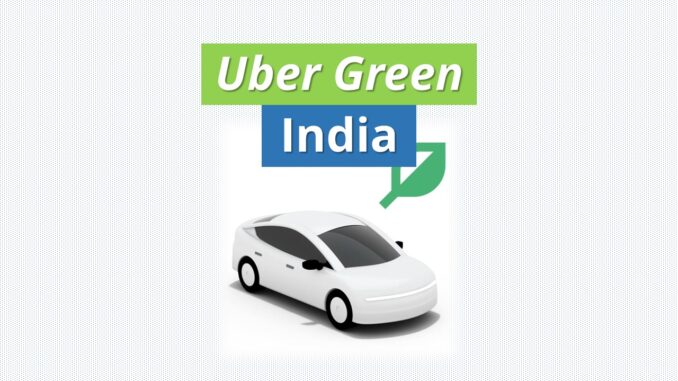
Uber, the global ride-hailing giant, has taken another significant stride towards sustainability with the launch of Uber Green in India. This initiative aims to provide environmentally friendly transportation solutions while reducing carbon emissions and promoting cleaner mobility options.
As one of the world’s largest markets, India’s adoption of UberGreen could have a transformative impact on the country’s transportation landscape.
Beginning in June, Uber will roll out its Uber Green service in three Indian cities, bringing the EV-only option to Delhi, Mumbai, and Bengaluru. In India, Uber also announced a wave of new EV collaborations.
Let’s explore the details of UberGreen’s launch in India and its potential implications for sustainable mobility.
Sustainable Transport For A Greener India
UberGreen, a new service introduced by Uber, is designed to cater to the growing demand for sustainable transportation solutions.
With India being one of the most populous countries globally and facing significant environmental challenges, the need for eco-friendly mobility alternatives has never been more crucial.
By launching UberGreen in India, Uber aims to play a pivotal role in reducing carbon emissions, improving air quality, and addressing the environmental impact of transportation.
This new service provides riders with the option to request electric vehicles (EVs) for their journeys, promoting cleaner modes of transportation while maintaining the convenience and reliability associated with Uber’s services.
Collaboration with Electric Vehicle Manufacturers
Uber has strategically partnered with leading electric vehicle manufacturers to ensure seamless integration of EVs into their platform.
By collaborating with automakers and encouraging the adoption of electric vehicles in India, UberGreen can not only contribute to the reduction of carbon emissions but also drive the growth of the EV industry in the country.
In a recent agreement, Uber and Tata agreed to work together to deploy 25,000 Xpres-T EV vehicles throughout Delhi, Mumbai, Bengaluru, Chennai, Hyderabad, and Ahmedabad.
Uber drivers are likely to receive special conditions for purchasing the Tata model, as is customary with agreements between Uber and automobile manufacturers (for Europe, these include Kia and Hyundai, as well as car rental business Hertz).
Additionally, Uber plans to work closely with local charging infrastructure providers to establish a robust network of charging stations across major cities in India.
The company also announced new deals with Lithium Urban Technologies, India’s largest B2B fleet service provider, Everest Fleet Private Limited, and Moove, Uber’s global fleet partner, which will help them roll out said 25,000 electric vehicles across the seven cities.
To finance the transition, Uber signed an MoU with India’s largest Small Industries Development Bank of India (SIDBI) to make Rupees 1000 Cr of low-interest loans available to its fleet partners to purchase EV and CNG vehicles.
This infrastructure development will address one of the key challenges associated with EV adoption by ensuring convenient and accessible charging facilities for UberGreen drivers, ultimately encouraging more drivers to switch to electric vehicles.
Environmental Benefits and Impacts of Uber Green
The launch of UberGreen in India has the potential to yield several notable environmental benefits. By replacing traditional fuel-powered vehicles with electric cars, the initiative can significantly reduce greenhouse gas emissions, improving air quality and mitigating the adverse effects of pollution on public health.
The adoption of EVs also contributes to the conservation of fossil fuels, promoting energy efficiency and reducing dependence on non-renewable resources.
Moreover, UberGreen’s presence in India could act as a catalyst for change within the broader transportation sector. As more users opt for electric vehicles through Uber’s platform, it can create a domino effect, inspiring other ride-hailing services, private vehicle owners, and even public transportation providers to explore sustainable mobility options.
This ripple effect could lead to a substantial reduction in overall carbon emissions from the transportation sector, helping India move closer to its climate goals.
Enhanced Rider Experience and Driver Opportunities from Uber Green
UberGreen not only benefits the environment but also enhances the overall rider experience. Electric vehicles are known for their quiet operation and smooth acceleration, providing a more comfortable and enjoyable ride.
Additionally, riders can take pride in knowing that they are actively contributing to the reduction of their carbon footprint with each UberGreen journey.
Furthermore, UberGreen presents new opportunities for drivers. As the demand for sustainable transportation grows, UberGreen drivers can attract a niche market of environmentally-conscious riders.
Additionally, Uber aims to provide comprehensive training and support to drivers who transition to electric vehicles, ensuring they are well-equipped to provide a seamless and efficient service.
Conclusion
UberGreen’s launch in India represents a significant step towards sustainable mobility in one of the world’s most populous and environmentally challenging countries.
By promoting the adoption of electric vehicles and creating a robust charging infrastructure, Uber aims to reduce carbon emissions, improve air quality, and inspire broader change within the transportation sector.
As riders and drivers increasingly embrace Uber Green, India has the potential to become a global leader in sustainable mobility. Through this initiative, Uber demonstrates its commitment to environmental responsibility.